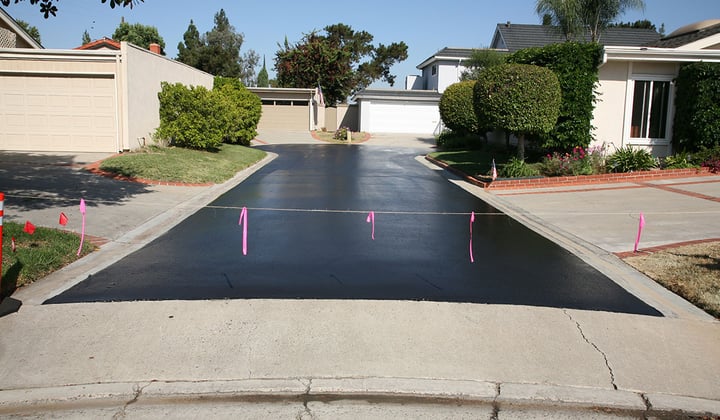Raise Pavement Efficiency: Cold Mix Asphalt Sealing Techniques
Raise Pavement Efficiency: Cold Mix Asphalt Sealing Techniques
Blog Article
Cold Mix Asphalt Vs. Hot Mix Asphalt: Which Is Right for You?

Structure Distinctions
Cold mix asphalt is created by emulsifying the asphalt binder with water and an emulsifying representative prior to mixing it with aggregate. The warm mix asphalt production process involves warming the accumulation and asphalt binder individually prior to incorporating them at the asphalt plant.
Furthermore, cold mix asphalt often tends to be much less dense and much more versatile than warm mix asphalt. This adaptability makes it much better matched for areas with higher degrees of movement, such as driveways or roads with rush hour. On the other hand, warm mix asphalt is understood for its high sturdiness and resistance to rutting and splitting, making it a preferred option for freeways and high-traffic roads where long life is important.
Setup Process Variances
The procedure of mounting cold mix and warm mix asphalt exhibits remarkable variations in their demands and procedures. In comparison, hot mix asphalt requires a much more sophisticated installation procedure. Due to the heating demands, hot mix asphalt installments are generally brought out by experts with specialized equipment, making certain an extra long-term and structurally sound result.
Resilience and Long Life Elements
When considering asphalt choices, resilience and durability are essential factors to examine for long lasting pavement performance. Warm mix asphalt (HMA) is understood for its outstanding resilience and longevity. The high temperature levels during the mixing and laying process enable for far better compaction, resulting in a denser and more powerful pavement framework. This results in HMA being extra immune to rush hour loads, extreme weather, and the effects of maturing contrasted to cold mix asphalt (CMA)
In terms of durability, HMA usually outmatches CMA because of its premium toughness and resistance residential or commercial properties. HMA pavements have a longer life span, calling for much less regular repair services and upkeep, which can equate to cost financial savings in the future. Furthermore, HMA pavements are more easily customizable to fulfill specific project requirements, additionally improving their longevity.
Price Considerations
Taking into consideration the economic implications is an essential element when evaluating the selection between warm mix asphalt (HMA) and cold mix asphalt (CMA) for pavement tasks. While the first cold mix asphalt cost of warm mix asphalt is generally higher than that of cool mix asphalt, HMA frequently supplies a more affordable remedy over time as a result of its remarkable sturdiness and longevity. HMA is known for its capacity to stand up to heavy website traffic loads and harsh climate condition, reducing the requirement for constant repairs and upkeep. On the other hand, chilly mix asphalt is more budget-friendly in advance however may need more constant patching and resurfacing, resulting in greater maintenance prices over time.
In addition to material costs, it's vital to consider the costs linked with installment and maintenance when contrasting HMA and CMA. Inevitably, the choice in between HMA and CMA must take into account not simply the preliminary cost yet also the long-lasting economic effects to identify the most affordable choice for the specific pavement project.
Environmental Effect Comparison
Contrast of the environmental effects between warm mix asphalt (HMA) and cold mix asphalt (CMA) discloses unique differences in sustainability methods. HMA manufacturing needs high temperature levels, leading to boosted power intake and greenhouse gas emissions. The process additionally releases unpredictable natural substances (VOCs) and hazardous air toxins (HAPs) right into the atmosphere. On the other hand, CMA is created and used at reduced temperature levels, minimizing energy usage and discharges substantially. The reduced production temperature levels of CMA lead to decreased fuel intake and reduced levels of carbon dioxide discharges, making it a more environmentally pleasant alternative.
Furthermore, the usage of CMA usually entails recycling existing asphalt pavement, advertising source preservation and lowering the amount of waste sent out to landfills. This reusing facet further enhances the sustainability of CMA compared to HMA. In general, when considering the environmental impact, CMA becomes a more eco sustainable option because of its reduced power demands, lowered discharges, and the capacity for reusing existing materials. By going with CMA over HMA, roadway building jobs can contribute favorably to ecological conservation efforts.
Final Thought
To conclude, the choice between cool mix asphalt (CMA) and hot mix asphalt (HMA) depends on different elements such as structure, installation process, sturdiness, durability, cost, and ecological influence. asphalt patch repair. While CMA supplies a cost-efficient and quick remedy for minor repairs, HMA ensures exceptional sturdiness and longevity for rush hour locations. Think about these aspects thoroughly to determine which kind of asphalt is the ideal choice for your paving requires

Taking into consideration the financial ramifications is an important aspect when examining the choice in between hot mix asphalt (HMA) and chilly mix asphalt (CMA) for pavement jobs. While the initial price of warm mix asphalt is commonly higher than that of chilly mix asphalt, HMA frequently provides a much more cost-efficient solution in the lengthy run due to its premium toughness and long life. cold mix asphalt.Contrast of the environmental impacts in between warm mix asphalt (HMA) and cool mix asphalt (CMA) discloses distinct differences in sustainability practices.In conclusion, the choice between cool mix asphalt (CMA) and hot mix asphalt (HMA) depends on different aspects such as structure, setup process, resilience, longevity, expense, and ecological influence
Report this page